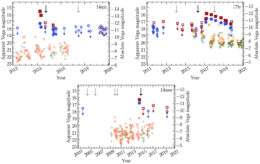An infrared survey of nearby galaxies revealed outbursting objects that defied existing classifications. Now, new optical observations with Hubble investigate whether these unusual objects are more than meets the (infrared) eye.
A Spirited Survey

Young stellar objects in dusty nebulae, like those in the Rho Ophiuchi cloud complex shown here in an image from the Wide-field Infrared Survey Explorer (WISE), are a potential source of the SPRITEs discovered by SPIRITS. [NASA/JPL-Caltech/UCLA]
Unlike other types of infrared transients, which flare into view at optical wavelengths during an outburst, SPRITEs remain hidden or extremely faint at wavelengths shorter than infrared even when they’re at their brightest. What might these SPRITEs be — supernovae cloaked in clouds of dust, young stars in natal nebulae, or something else entirely?

Spitzer light curves for three of the objects studied. Blue symbols indicate 4.5-micron measurements and red symbols indicate 3.6-micron measurements. The remaining symbols indicate upper limits. Click to enlarge. [Adapted from Bond et al. 2022]
Diving Deep with Hubble
In a new publication led by Howard Bond (Penn State University and Space Telescope Science Institute), a team of astronomers performed deep optical and near-infrared imaging with the Hubble Space Telescope to take a closer look at 21 SPIRITS targets, most of which were classified as SPRITEs. Their goal was to detect optical counterparts for these infrared transients and characterize their environments in order to identify the source of the outbursts.
Many of the targets were still not detected in the Hubble observations, but observations of their surroundings yielded new insights into their identities. What’s more, the team continued to monitor the targets with Spitzer, leading to entirely new classifications for many of the objects: of the 21 supposed transients, only three retained that moniker, while a dozen others were discovered to have periodic behavior, and six were found to vary irregularly. How has this affected our understanding of the SPIRITS targets and SPRITEs specifically?
From Transient to Periodic

Hubble images of the site of SPRITE 17fe, which is marked with a red cross in the top image. The middle row shows a zoomed-in view of the site years before the outburst in three different wavelength bands. The bottom row shows the same field during an outburst — 0.8 years after the peak — in two near-infrared bands. [Bond et al. 2022]
The objects found to vary periodically did so over extremely long timescales (from 670 to more than 2,100 days) and tended to be found near star-forming regions. Comparison with known types of variable stars indicates that these slowly varying sources are likely dusty, evolved giant stars with masses in the 5–10 solar-mass range. The irregular variables detected in Hubble images might be pulsating red supergiants, while the redder variables undetected at Hubble wavelengths might be associated with mass-loss events of extremely dusty luminous blue variable stars.
There’s still much to learn about the dusty objects identified by SPIRITS. Infrared spectroscopy is likely to illuminate the nature of these sources and luckily, JWST and future observatories like the Roman Space Telescope should be more than equal to the task. For a detailed discussion of each target studied by Bond and collaborators, be sure to check out the full article cited below!
Citation
“Hubble Space Telescope Imaging of Luminous Extragalactic Infrared Transients and Variables from the Spitzer Infrared Intensive Transients Survey,” Howard E. Bond et al 2022 ApJ 928 158. doi:10.3847/1538-4357/ac5832
